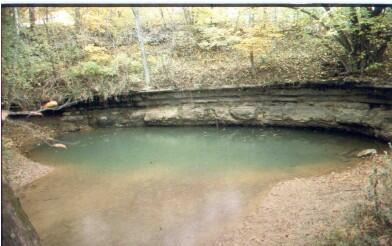Karst Aquifers: Midwest Paleozoic Carbonate Aquifers
The porosity of carbonate and dolomitic units in Midwest Paleozoic rocks has been enhanced by dissolution, and in many areas these rocks have undergone extensive karst development. This aquifer demonstrates karst features such as disappearing streams, springs, and caves.
The porosity of carbonate and dolomitic units in Midwest Paleozoic rocks has been enhanced by dissolution, and in many areas these rocks have undergone extensive karst development. The greatest karst development as occurred in Devonian-Silurian and Cambrian-Ordovician rocks. The vertical sequence of the aquifers and confining units varies across the region.
In Iowa and Michigan, solution-enhanced dissolution of Mississippian dolomitic rocks has resulted in karst flow systems.
Limestones in the Devonian-Silurian aquifer system in Ohio, Indiana, Illinois, Iowa, and Wisconsin have undergone extensive karst development. The limestones outcrop in some areas, and in others are overlain by up to several hundred meters of unconsolidated Quaternary deposit. Throughout this area, large well yields are possible from these units.
Some limestone and dolomites Cambrian-Ordovian rocks underlying the Silurian-Devonian aquifer also have undergone extensive karst development. These are water-producing units in parts of Illinois, Wisconsin, Minnesota and Iowa. In southeastern Minnesota and northern Iowa these are referred to as the upper carbonate aquifer, and is extremely productive.
Because of the prevalence of agriculture and livestock in this part of the United States, contamination of karst aquifers with nutrients, pesticides, and bacteria is of much concern. In Iowa, for example, regulations have been developed for some confined animal feeding operations in karst terrain.
Disappearing Streams

Springs

Caves
Additional Information
The following websites are additional sources of information about this aquifer:
Below are other science projects associated with karst aquifers.
Karst Aquifers
Karst Aquifers: Arbuckle-Simpson Aquifer
Karst Aquifers: Basin and Range and Bear River Range Carbonate Aquifers
Karst Aquifers: Colorado Plateau Karst
Karst Aquifers: Edwards Balcones Fault Zone Aquifer
Karst Aquifers: Edwards-Trinity Plateau Aquifer
Karst Aquifers: Upper Floridan and Biscayne Aquifers
Karst Aquifers: Madison Aquifer
Karst Aquifers: Midwest Paleozoic Carbonate Aquifers
Karst Aquifers: New England Karst Aquifers
Karst Aquifers: Ozark Plateau Karst Aquifers
Karst Aquifers: Roswell Basin Aquifer
Karst Aquifers: Pacific Northwest Pseudokarst Aquifers
The porosity of carbonate and dolomitic units in Midwest Paleozoic rocks has been enhanced by dissolution, and in many areas these rocks have undergone extensive karst development. This aquifer demonstrates karst features such as disappearing streams, springs, and caves.
The porosity of carbonate and dolomitic units in Midwest Paleozoic rocks has been enhanced by dissolution, and in many areas these rocks have undergone extensive karst development. The greatest karst development as occurred in Devonian-Silurian and Cambrian-Ordovician rocks. The vertical sequence of the aquifers and confining units varies across the region.
In Iowa and Michigan, solution-enhanced dissolution of Mississippian dolomitic rocks has resulted in karst flow systems.
Limestones in the Devonian-Silurian aquifer system in Ohio, Indiana, Illinois, Iowa, and Wisconsin have undergone extensive karst development. The limestones outcrop in some areas, and in others are overlain by up to several hundred meters of unconsolidated Quaternary deposit. Throughout this area, large well yields are possible from these units.
Some limestone and dolomites Cambrian-Ordovian rocks underlying the Silurian-Devonian aquifer also have undergone extensive karst development. These are water-producing units in parts of Illinois, Wisconsin, Minnesota and Iowa. In southeastern Minnesota and northern Iowa these are referred to as the upper carbonate aquifer, and is extremely productive.
Because of the prevalence of agriculture and livestock in this part of the United States, contamination of karst aquifers with nutrients, pesticides, and bacteria is of much concern. In Iowa, for example, regulations have been developed for some confined animal feeding operations in karst terrain.
Disappearing Streams

Springs

Caves
Additional Information
The following websites are additional sources of information about this aquifer:
Below are other science projects associated with karst aquifers.



